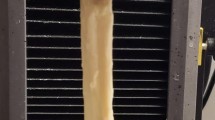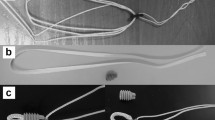Abstract
As one of the most frequently used grafts in anterior cruciate ligament (ACL) reconstruction, hamstring tendon (HT) grafts are prepared with different lengths and fixed by specific fixations in knee joints. However, there are incomplete studies to investigate both the joint kinematics and graft biomechanics in the ACL reconstructions with different HT graft lengths. In this paper, three different graft lengths (i.e., 30, 50, and 70 mm) were developed in the ACL reconstruction and analyzed using finite element method under two usual clinical test loads (i.e., 134 N anterior tibial drawer and pivot shift test load). The different mechanical properties of the corresponding fixations were also considered for each graft length. It was revealed that the change in HT graft length would cause different strain and stress results in the grafts, but did not greatly influence joint stabilities under the two clinical test loads. The graft reaction force at the femoral fixation was always greatly lower than that at the tibial fixation regardless of load and graft length. The comparison of stress and strain results also indicated that more graft tissues inside the femoral and tibial tunnels could decrease the stress and strain values at the femoral and tibial fixation sites, respectively.






Similar content being viewed by others
References
Abramowitch SD, Zhang X, Curran M, Kilger R (2010) A comparison of the quasi-static mechanical and non-linear viscoelastic properties of the human semitendinosus and gracilis tendons. Clin Biomech 25:325–331
Adachi N, Ochi M, Uchio Y, Sakai Y, Kuriwaka M, Fujihara A (2003) Harvesting hamstring tendons for ACL reconstruction influences postoperative hamstring muscle performance. Arch Orthop Traum Surg 123:460–465
Ao YF (2004) Operative arthroscopy of the knee. Peking University Medical Press, Beijing
Bae JY, Kim G, Seon JK, Jeon I (2016) Finite element study on the anatomic transtibial technique for single-bundle anterior cruciate ligament reconstruction. Med Biol Eng Comput 54:811–820
Blackburn JT, Norcross MF, Padua DA (2011) Influences of hamstring stiffness and strength on anterior knee joint stability. Clin Biomech 26:278–283
Butler DL, Kay MD, Stouffer DC (1986) Comparison of material properties in fascicle-bone units from human patellar tendon and knee ligaments. J Biomech 19(6):425–432
Chow JCY (2001) Advanced arthroscopy. Springer, New York
DeFrate LE, van der Ven A, Gill TJ, Li G (2004) The effect of length on the structural properties of an achilles tendon graft as used in posterior cruciate ligament reconstruction. Am J Sports Med 32(4):993–997
Diermann N, Schumacher T, Schanz S et al (2009) Rotational instability of the knee internal tibial rotation under a simulated pivot shift test. Arch Orthop Traum Surg 129:353–358
El’Sheikh HF, MacDonald BJ, Hashmi MSJ (2003) Finite element simulation of the hip joint during stumbling: a comparison between static and dynamic loading. J Mater Process Technol 143–144:249–255
Grood ES, Suntay WJ (1983) A joint coordinate system for the clinical description of three-dimensional motions: application to the knee. J Biomech Eng 105:136–144
Grover D, Thompson D, Hull ML, Howell SM (2006) Empirical relationship between lengthening an anterior cruciate ligament graft and increases in knee anterior laxity A human cadaveric study. J Biomech Eng 128:969–972
Hogervorst T, van der Hart CP, Pels RT, Taconis WK (2000) Abnormal bone scans of the tibial tunnel 2 years after patella ligament anterior cruciate ligament reconstruction: correlation with tunnel enlargement and tibial graft length. Knee Surg Sports Traumatol Arthrosc 8:322–328
Jagodzinski M, Foerstemannb T, Mallc G et al (2005) Analysis of forces of ACL reconstructions at the tunnel entrance is tunnel enlargement a biomechanical problem. J Biomech 38:23–31
Kawaguchi Y, Kondo E, Kitamura N et al (2011) Comparisons of femoral tunnel enlargement in 169 patients between single-bundle and anatomic double-bundle anterior cruciate ligament reconstructions with hamstring tendon grafts. Knee Surg Sports Traumatol Arthrosc 19:1249–1257
Kousa P, Jarvinen TLN, Vihavainen M, Kannus P, Jarvinen M (2003) The fixation strength of six hamstring tendon graft fixation devices in anterior cruciate ligament reconstruction. Part II: tibial site. Am J Sports Med 31(2):182–188
Lewis JL, Lew WD, Engebretsen L, Hunter RE, Kowalczyk C (1990) Factors affecting graft force in surgical reconstruction of the anterior cruciate ligament. J Orthop Res 8:514–521
Li G, DeFrate L, Suggs J, Gill T (2003) Determination of optimal graft lengths for posterior cruciate ligament reconstruction: a theoretical analysis. J Biomech Eng 125:295–299
Li S, Su W, Zhao J, Xu Y, Bo Z, Ding X, Wei Q (2011) A meta-analysis of hamstring autografts versus bone-patellar tendon-bone autografts for reconstruction of the anterior cruciate ligament. Knee 18:287–293
McGinty JB (1991) Operative arthroscopy. Raven Press, New York
Mesfar W, Shirazi-Adl A (2006) Biomechanics of changes in ACL and PCL material properties or prestrains in flexion under muscle force-implications in ligament reconstruction. Comput Methods Biomech Biomed Eng 9(4):201–209
Milano G, Mulas PD, Ziranu F, Piras S, Manunta A, Fabbriciani C (2006) Comparison between different femoral fixation devices for ACL reconstruction with doubled hamstring tendon graft: a biomechanical analysis. Arthroscopy 22(6):660–668
Neddermann A, Willbold E, Witte F et al (2009) Tunnel widening after anterior cruciate ligament reconstruction an experimental study in sheep. Am J Sports Med 37:1609–1617
Pena E, Martinez MA, Calvo B, Palanca D, Doblare M (2005) A finite element simulation of the effect of graft stiffness and graft tensioning in ACL reconstruction. Clin Biomech 20:636–644
Pena E, Calvo B, Martinez MA, Palanca D, Doblare M (2006) Influence of the tunnel angle in ACL reconstructions on the biomechanics of the knee joint. Clin Biomech 21:508–516
Quapp KM, Weiss JA (1998) Material characterization of human medial collateral ligament. J Biomech Eng 120:757–763
Rodeo SA, Arnoczky SP, Torzilli PA, Hidaka C, Warren RF (1993) Tendon-Healing in a Bone Tunnel. J Bone Joint Surg 75-A(12):1795–1803
Sajovic M, Strahovnik A, Dernovsek MZ, Skaza K (2011) Quality of life and clinical outcome comparison of semitendinosus and gracilis tendon versus patellar tendon autografts for anterior cruciate ligament reconstruction. Am J Sports Med 39(10):2161–2169
Shacham S, Castel D, Gefen A (2010) Measurements of the static friction coefficient between bone and muscle tissues. J Biomech Eng 132:0845028
Smith CK, Hull ML, Howell SM (2010) Does graft construct lengthening at the fixations cause an increase in anterior laxity following anterior cruciate ligament reconstruction in vivo? J Biomech Eng 132:081001
Suggs J, Wang C, Li G (2003) The effect of graft stiffness on knee joint biomechanics after ACL reconstruction-a 3D computational simulation. Clin Biomech 18:35–43
Tsuda E, Fukuda Y, Loh JC, Debski RE, Fu FH, Woo SL (2002) The effect of soft-tissue graft fixation in anterior cruciate ligament reconstruction on graft-tunnel motion under anterior tibial loading. Arthroscopy 18(9):960–967
Wan C, Hao ZX, Wen SZ (2013) The effect of the variation in ACL constitutive model on joint kinematics and biomechanics under different loads: a finite element study. J Biomech Eng 135:041002
Wan C, Hao ZX, Wen SZ (2014) The effect of the material property change of anterior cruciate ligament by ageing on joint kinematics and biomechanics under tibial varus/valgus torques. Bio-Med Mater Eng 24(1):1375–1382
Wan C, Hao ZX, Wen SZ (2016) The effect of healing in the medial collateral ligament of human knee joint: a three-dimensional finite element analysis. Proc Inst Mech Eng H-J Eng Med 230(9):867–875
Weiss JA, Gardiner JC, Bonifasi-Lista C (2002) Ligament material behavior is nonlinear, viscoelastic and rate-independent under shear loading. J Biomech 35(7):943–950
Yasuda K, Tsujino J, Tanabe Y, Kaneda K (1997) Effects of initial graft tension on clinical outcome after anterior cruciate ligament reconstruction. Autogenous doubled hamstring tendons connected in series with polyester tapes. Am J Sports Med 25:99–106
Acknowledgements
This work was supported by the China Postdoctoral Science Foundation under Grant [2015M570085] and the National Nature Science Foundation of China under Grant [51275267].
Author information
Authors and Affiliations
Corresponding author
Ethics declarations
Conflict of interest
No conflict of interest.
Electronic supplementary material
Below is the link to the electronic supplementary material.
Rights and permissions
About this article
Cite this article
Wan, C., Hao, Z., Li, Z. et al. Finite element simulations of different hamstring tendon graft lengths and related fixations in anterior cruciate ligament reconstruction. Med Biol Eng Comput 55, 2097–2106 (2017). https://doi.org/10.1007/s11517-017-1637-7
Received:
Accepted:
Published:
Issue Date:
DOI: https://doi.org/10.1007/s11517-017-1637-7




